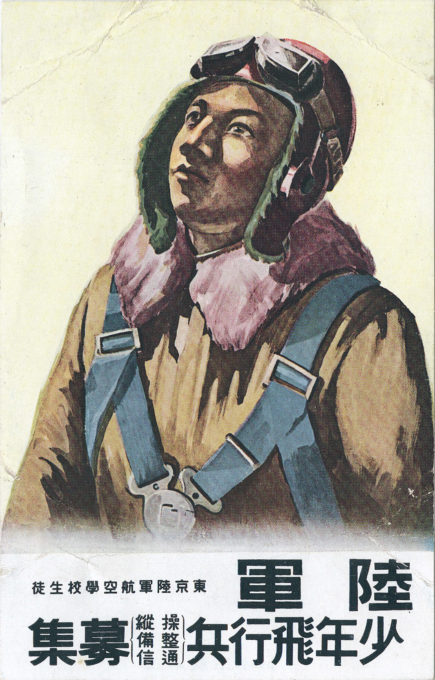“The final and most powerful king of [the] ‘carnival war’ was the youth aviator who dazzled the home front with visions of consumerist desire, before inverting into the kamikaze pilot during the last year of the Pacific War.
“His 1940 debut in the mass media occurred as the home front began to shift attention from the ground war in China to potential aerial warfare in the Pacific against the United States. Through glossy pilot recruitment posters, state-sponsored aviation events, aviation movies, and aviation fan magazines, he became the object of desire and admiration for millions of Japanese as consumers and as subjects.
“Coming into his own in late wartime Japan, the youth aviator derived his magnetic power by mimicking the characteristics of other carnival kings. Like the munitions worker and the movie star, he offered tantalizing possibilities of consumption and glamor within wartime austerity for the Japanese consumer-subject, while also serving state goals to mobilize war technology and violence.
“… Like the soldier as ‘military god’, he ably performed as an avatar of martial courage and daring but unlike the emasculated returned soldier, he represented a younger, more vigorous idea of soldierly masculinity rooted in triumph and technology.”
– Japan’s Carnival War: Mass Culture on the Home Front, 1937-1945, by Benjamin Uchiyama, 2019

“Student at Tokyo Army Aviation School” Army Aviation Headquarters propaganda postcard, c. 1940. The Tokyo Army Aviation School was founded in 1937 to train “boy pilots”, 15-17 year old teenagers, who were given a basic flight school education before formal enlistment into the army and further training at advanced flight schools. Nearby was situated Kumagaya Army Flight School, a principal Imperial Japanese Army advanced flight school.
See also:
“Girls manufacturing parachutes”, propaganda postcard, c. 1945.
“Grab the weapon for production increase”, propaganda postcard, c. 1940.
“Tokyo Army Aviation School was one of the military schools of the Japanese Imperial Army . It was colloquially named ‘Toko’ [東航], an abbreviation of its full name, Tokyo rikugun koukuu gakkou. Basic aeronautical education was provided to teenage students who applied to become ‘boy pilots’ who would then graduate to become active duty non-commissioned officers in the Imperial Japanese Army Air Force.
Opened in December 1937, the school headquarters and main school were established on the premises of the Kumagaya Army Flight School in Saitama Prefecture. In October 1942, an additional flight school, the Tokyo Army Aviation School Otsu Training Corps, was established in Otsu City, Shiga Prefecture, with half of the existing 2200 Tokyo Army Aviation School ‘boy pilots’ being reassigned to the new training ground.
“The purpose of this basic flight school education is to cultivate in students the character, morals, and spirit necessary to become pilots, and to have the necessary background to graduate to “advanced schools” for aeronautical training. New students were usually admitted twice each year, in April or October, with basic training completed in one year and then further assignment to one of three aviation divisions: piloting, maintenance or communications. After completing this basic education, students were then assigned to advanced schools based on their designated specialty.
“Minimum requirements for enrollment included:
To be at least 15 years old and under 17 years old;. To have passed a prescribed physical examination; To have attained the equivalent of graduation from an ordinary elementary school, and pass examinations in Japanese, mathematics, history, and science. “After the school’s subsequent closure and dissolution at the end of the Pacific War, the site of the Tokyo Army Aviation School was sold as farmland. In 1966, the former aviation school site became a municipal housing complex. In September 2016, the Musashi-Murayama City History and Folklore Museum annex was opened in a corner of the site to display related historical Tokyo Army Aviation School materials.”
– Wikipedia


Pingback: Great Japan Aviation Boy Scouts (“Dai Nihonkōkū seishōnen-tai”) recruitment postcard, c. 1938. | Old Tokyo